Chapter II. Saint-Amand-les-Eaux.
I. Their arrival at Saint-Amand (1875).
The provisional house. – Trials and consolations.
Saint-Amand-les-Eaux is a little town in the Department of the North, famous for its ancient abbey, whose imposing ruins still evoke astonishment from travellers. It is also renowned for its medicinal waters or mud, whose effect is truly salutary. And so, on the evening of 14th October 1875, Mother Marie-Joseph arrived in this town. She was accompanied by Sister Marie-Madeleine of the Cross, the sister of Mr. Prosper Basiez, the pious lay promoter of the new foundation; Sister Marie-Claire of the Blessed Sacrament; Sister Marie-Ange of the Precious Blood; Sister Marie-Augustine of the divine Providence, who belonged to the community of Velp (Holland), and the niece of Sister Marie-Madeleine; and finally two converse Sisters completed the community, which was entirely of French nationality.
The little colony in the company of Rev. Father de Buggenoms, was received at Lille by Rev. Father Darras, of holy memory, with the most touching cordiality. That evening they were at Saint-Amand. In the light of some pale torches, the Sisters were able to see that the house that had been prepared for them bore the heraldry of poverty. This was the first joy to their hearts. They also saw with pleasure that the furnishing of the kitchen, the gift of charitable benefactors, was similar. Some good straw mattresses, on which they would soon enjoy a refreshing sleep, completed the scene.
On the evening of 15th October, the feast of Saint Therese, Father Duriez, the Dean of Saint-Amand, came to bless the little chapel and placed it under the patronage of the Holy Family. The next day, Father de Buggenoms celebrated the Holy Mass and left the Sisters the treasure of treasures, the Blessed Sacrament. On Sunday the 17th, Father Vaillant, the community’s chaplain, began the ministry that he was to exercise for twenty seven years with a devotion above all praise. Finally, on 5th November, the work of taking possession having been completed, the Dean came to proceed to the ceremony of the enclosure. On that day, a Te Deum of thanksgiving united the voices of the founders and foundresses in a concert of praises to the Sacred Heart of Jesus.
The life of the community began in poverty, as they had foreseen in the beginning, but also in happiness and peace. Their food was rather scanty, and their resources scarcely sufficient, but Mother Marie-Joseph, through her goodness and examples, stimulated their courage. Soon illness came to be added to their privations. Two Sisters fell ill, and the work of the household, already great, now increased. Water invaded the cellars and they had to get rid of it. In short, there was no lack of sorrows, but everyone had their courage for the work.
However, divine Providence, in whom the good Mother placed her trust, never once failed her. Several times, she found that the payment of the least expenses had not made a hole in her purse, and then, the Sisters of Ireland, whose Superior was Mother Marie-Jeanne de la Croix, gave evidence of their fraternal charity by incessant offerings, always received with gratitude. Other offerings could be recalled here if the limits of our account and the modesty of the benefactors did not impose silence on us.
Soon some postulants presented themselves. The first of them made her entry on 29th February of this leap-year 1876. She herself gives an account in these terms of the history of her admission. “On 2nd February, I presented myself to the Reverend Mother Marie-Joseph, and this first interview left me with a very sweet impression. The goodness, courtesy and simplicity of the Reverend Mother charmed me, and from then on I devoted all my affection to her. Some weeks later, I made my entry into the Monastery, which I found in the most complete state of poverty. They took me to the Educandate, which, it seems, they had hardly prepared to receive me, and which was nothing else than a corner in the attic. A tiny altar had been placed against a wall, decorated with fixtures in pearls. I could not prevent myself from laughing when I entered that garret, which reminded me more of Bethlehem than Nazareth. The floor was so worm-eaten that the foot of my chair made a hole in it the first time I sat down. The beams of the roof were laid bare, and in place of a cupboard they were using a corner of the attic into which they had fitted a door. In spite of this extreme poverty, I was convinced that I would find the happiness there promised to the poor in spirit. The example of the Reverend Mother and the Sisters would fortify my courage and inspire me to sacrifice. My expectations were not deceived.”
Other young persons did not delay in presenting themselves, and on 6th February the following year (1877), on the feast of Saint-Amand, the protector of the city, they were able to give the holy habit of the Order to three novices who received the names of Sister Marie-Alphonse of the Sacred Heart of Jesus, Sister Marie-Paul of Jesus Crucified, and Sister Marie-Josephine of Jesus. On 9th February of the following year, the first two were admitted to holy profession, and Rev. Father Berthe, Redemptorist, gave the customary sermon. The eloquent preacher did not fail to recommend to the Sisters’ prayers the soul of the glorious Pius IX, who had died two days previously (7th February 1878). The community made it their duty to unite their prayers to the entire world. The Holy Sacrifice was offered and the Divine Office celebrated for the holy Pontiff.
The successor to Pius IX was his Holiness Leo XIII. The community soon received his blessing through the medium of Mr. Etienne Basiez, received in audience with the French pilgrims. When he begged the Holy Father to bless the Redemptoristines of France, His Holiness replied: “Yes, I bless these good religious.” The Holy Father, who had met the Redemptoristines of Bruges when he was the Nuncio in Belgium, repeated his blessing some time afterwards, when he gave an audience to the Most Rev. Father Mauron, the Rector Major of the Congregation of the Most Holy Redeemer. He added some advice for always maintaining the good spirit and fervour of the Order. This advice was faithfully transmitted to Saint-Amand by the Very Rev. Father Desurmont, the Provincial of the French Province. This holy religious took the keenest interest in the nascent foundation.
II. The New Monastery.
However, the consolations of the present and concern for the future required them to think of leaving a residence that had now become too cramped. Mother Marie-Joseph then turned to His Lordship Mons. Monnier, the coadjutor to Mons. Régnier, the Archbishop of Cambrai, to explain her views and her wish to build a Monastery that would respond entirely to the exigencies of religious life. The venerated Prelate, who for more than forty years did not cease to be the devoted protector of the community, approved the project and gave all the authorisations necessary. Then the good Mother, in the company of two Sisters, went to examine a property situated in Bruille Street, which had been suggested. The sale was completed, and on 21st June 1877, the first stone of the new building was laid. The Monastery was to be constructed according to the plans drawn up by Mr. Leroux, architect, an employee of Mrs. V. Maillard of Tourcoing.
Fifteen months were sufficient for the building, which the good Mother had managed to superintend, and which was constructed under the best conditions. Beginning from 20th September 1878, there was a dispensation from the enclosure to permit the Sisters to tidy up their future convent. On 24th, the Rev. Father Darras, the extraordinary confessor of the community, came to bless the cells, and on 1st October, at five o’clock in the evening, Father Duriez, the Dean of Saint-Amand, blessed the temporary chapel, and it was decided that on the following day the Community would leave Condé Street and move in to their new Monastery. It was not without regret that they were about to say farewell to their little Nazareth, where they had encountered the sweetness of their first trials and their first joys, but they were also happy to have a stable home from now on where they could work without concerns of any kind for the glory of God and the salvation of souls.
The departure took place on 2nd October, on the feast of the Holy Guardian Angels. Some pious families sent their carriages in which the fifteen religious who formed the community took their place. They then went in procession to the choir in the new Monastery, the Holy Mass was celebrated, and after a fervent thanksgiving, they had a frugal lunch which was shared by some ladies, the relatives or friends of the Sisters.
Some days afterwards, Mons. Fava, the Bishop of Grenoble, accompanied by his secretary and nephew, Father Méresse, came to visit the Sisters and bring them the wonderful news of the Redemptoristines recently being established at Grenoble. Then on 16th October, it was the good Father Darras who came to bless the Monastery clock, the clock, this faithful and vigilant guardian of regularity. Finally, on 31st August 1879, Mons. Monnier came to perform the solemn ceremony of the establishment of the enclosure. The Vicar General, Father Destombes, the Dean of Saint-Amand, Father Sinsoillez, the Superior of the College of Our Lady of the Angels and Father Vaillant enhanced this ceremony with their presence. His Lordship gave the community an excellent sermon. Monsignor reminded the Sisters of the beauty of their vocation and the obligations it entailed. He promised them, in return for their fidelity, the heavenly joys and consolations. This pious solemnity, which finished worthily with a Papal blessing, finally delivered the community to the peaceful and calm life which is its ordinary element.
Mons. Monnier had preached on the love of sacrifice. The first sacrifice which was imposed on the community by Providence was to be separated from one of its best subjects. The house of Grenoble had just lost its worthy Superior and foundress, Mother Marie-Véronique. It asked Saint-Amand for a subject capable of receiving this inheritance. The community’s choice fell upon Sister Marie-Augustine of the divine Providence. The good Sister had rendered immense services to the Monastery during the three years she had spent there. Her cheerfulness, her energy and her extraordinary love of work had sustained their courage and inspired their good will many times. So they separated with regret, but with the sweet thought that God Himself wanted this departure. The new Superior left on 1st February 1880.
Another separation, equally sorrowful, was brought about by the death of the oldest of the founding Sisters (1st February 1883). Sister Marie-Madeleine of the Cross was aged 69, 40 of which were passed in religion. A model of regularity and fervour, this good religious had earnestly asked her Superior not to let her be interred in the cemetery of Saint-Amand, where, as she said, she could find herself beside a hanged criminal, as the graves were mixed together indiscriminately. Mother Marie-Joseph acquiesced with her request, and bought a concession of land in the cemetery of Nivelles, and this is where Sister Marie-Madeleine was interred. Later on they constructed a vault, and it is there that the Sisters went to sleep their last sleep while awaiting their glorious resurrection.
But if the sacrifice was there, then the promised joys were never lacking. Seven professions had increased the number of the Sisters since the opening of the new Monastery. The Archbishopric rewarded this progress by associating the community with the perpetual adoration established in the Diocese. The favour of nocturnal Adoration was also granted (1882).
The 28th April 1884 was a feast day in the Monastery. They celebrated the 25th anniversary of the religious profession of the Mother Foundress. The humility and modesty of the good Mother did not permit them to give this feast the publicity it deserved, but everyone’s hearts were united in the most sincere prayers and expressions of the greatest gratitude. In addition, the community did not neglect any occasion to witness its gratitude to her who was the true Mother of all the Sisters and the support of each one of them: Saint Joseph, her patron’s feast, the anniversaries of her birth, her entry into religion, her taking of the habit, her religious profession and her entry into responsibility were all celebrated with great happiness. At each triennium, they earnestly sought her re-election, and this favour, which was a remarkable thing, was granted right up to the death of the Foundress, a striking witness to the affection of which she was the object.
However, the days were passing by without one of the most dear wishes of Mother Marie-Joseph being realised – the construction of a chapel. After seven years of waiting, divine Providence rewarded her desires by the medium of Miss Eugenie Grimonprez of Valenciennes. When she entered religion on 29th June 1884, Sister Marie-Aloyse of the Eucharistic Jesus brought with her not just the virtues which were to call her one day to the dignity of Superior, but also the dowry which permitted them to elevate to the Lord the chapel they so ardently desired. It was begun on 8th September 1885. This pretty chapel, the work of Mr. J. B. Maillard, an architect of Tourcoing, was blessed on 23rd June following. When they began it, they would never have expected it to be totally completed.
The time for the profession of Sister Marie-Aloyse had arrived, and they could do no better than to celebrate this pious ceremony in the beautiful sanctuary that she had given so generously. Father Prouvost, the Dean of Our Lady of Valenciennes was the presider at the feast and Rev. Father Berthe gave the usual homily.
Mother Marie-Joseph wanted to use it for splendid celebrations of the feasts of the Church, and also the feasts of the great family of the Most Holy Redeemer. One of these last was particularly a subject of joy for her: the celebration of the first centenary of the death of Saint Alphonsus (1787-1887). Mons. Monnier, the Bishop of Lydda, was happy to be the presider at the ceremonies of 31st July, and 1st and 2nd August and also give the address on the day of the holy Doctor’s feast.
The Beatification of the Venerable Brother Gerard Majella was equally well celebrated in the Monastery of Saint-Amand. Three entire days were given to it in November 1893. A Redemptorist Father exalted the newly Blessed and called on all those attending to have recourse to his powerful intercession. On the third day, an imposing ceremony was conducted by Mons. Monnier - the solemn consecration of the beautiful altar all shining with marble and gold. The Venerable Prelate, in an excellent homily, first of all explained the mysterious and symbolic sense of the prayers and benedictions prescribed in these circumstances by the holy liturgy. Then he proceeded to carrying out the sacred rites. Everyone brought away the sweetest memories from these beautiful feasts.
The year 1899 was marked by a very special event. Many projects of foundation had already been conceived without anyone being able to realise them. But that year a new foundation, issuing from Saint-Amand, was inaugurated at Armentières. It was Sister Marie-Alphonsa of Our Lady of Perpetual Succour who was chosen to be its Superior. She left Saint-Amand on 18th September of that year, accompanied by Sister Marie-Berchmans of the Holy Spirit to superintend the works and make the arrangements for the new Monastery. Later on, Mother Marie-Joseph herself brought two other religious, and she continued to help this nascent house with her wise counsels. Today it has become the flourishing house of Maffles (Belgium).
Such were the principal exterior events that marked the twenty five years whose history we have just sketched. But we have said nothing of the interior life of Mother Marie-Joseph. So now, in outlining the virtues of the venerated Superior, we must show how she knew how to govern the Monastery she had founded wisely, and make the beautiful tree she had planted produce the fruits of salvation.
The provisional house. – Trials and consolations.
Saint-Amand-les-Eaux is a little town in the Department of the North, famous for its ancient abbey, whose imposing ruins still evoke astonishment from travellers. It is also renowned for its medicinal waters or mud, whose effect is truly salutary. And so, on the evening of 14th October 1875, Mother Marie-Joseph arrived in this town. She was accompanied by Sister Marie-Madeleine of the Cross, the sister of Mr. Prosper Basiez, the pious lay promoter of the new foundation; Sister Marie-Claire of the Blessed Sacrament; Sister Marie-Ange of the Precious Blood; Sister Marie-Augustine of the divine Providence, who belonged to the community of Velp (Holland), and the niece of Sister Marie-Madeleine; and finally two converse Sisters completed the community, which was entirely of French nationality.
The little colony in the company of Rev. Father de Buggenoms, was received at Lille by Rev. Father Darras, of holy memory, with the most touching cordiality. That evening they were at Saint-Amand. In the light of some pale torches, the Sisters were able to see that the house that had been prepared for them bore the heraldry of poverty. This was the first joy to their hearts. They also saw with pleasure that the furnishing of the kitchen, the gift of charitable benefactors, was similar. Some good straw mattresses, on which they would soon enjoy a refreshing sleep, completed the scene.
On the evening of 15th October, the feast of Saint Therese, Father Duriez, the Dean of Saint-Amand, came to bless the little chapel and placed it under the patronage of the Holy Family. The next day, Father de Buggenoms celebrated the Holy Mass and left the Sisters the treasure of treasures, the Blessed Sacrament. On Sunday the 17th, Father Vaillant, the community’s chaplain, began the ministry that he was to exercise for twenty seven years with a devotion above all praise. Finally, on 5th November, the work of taking possession having been completed, the Dean came to proceed to the ceremony of the enclosure. On that day, a Te Deum of thanksgiving united the voices of the founders and foundresses in a concert of praises to the Sacred Heart of Jesus.
The life of the community began in poverty, as they had foreseen in the beginning, but also in happiness and peace. Their food was rather scanty, and their resources scarcely sufficient, but Mother Marie-Joseph, through her goodness and examples, stimulated their courage. Soon illness came to be added to their privations. Two Sisters fell ill, and the work of the household, already great, now increased. Water invaded the cellars and they had to get rid of it. In short, there was no lack of sorrows, but everyone had their courage for the work.
However, divine Providence, in whom the good Mother placed her trust, never once failed her. Several times, she found that the payment of the least expenses had not made a hole in her purse, and then, the Sisters of Ireland, whose Superior was Mother Marie-Jeanne de la Croix, gave evidence of their fraternal charity by incessant offerings, always received with gratitude. Other offerings could be recalled here if the limits of our account and the modesty of the benefactors did not impose silence on us.
Soon some postulants presented themselves. The first of them made her entry on 29th February of this leap-year 1876. She herself gives an account in these terms of the history of her admission. “On 2nd February, I presented myself to the Reverend Mother Marie-Joseph, and this first interview left me with a very sweet impression. The goodness, courtesy and simplicity of the Reverend Mother charmed me, and from then on I devoted all my affection to her. Some weeks later, I made my entry into the Monastery, which I found in the most complete state of poverty. They took me to the Educandate, which, it seems, they had hardly prepared to receive me, and which was nothing else than a corner in the attic. A tiny altar had been placed against a wall, decorated with fixtures in pearls. I could not prevent myself from laughing when I entered that garret, which reminded me more of Bethlehem than Nazareth. The floor was so worm-eaten that the foot of my chair made a hole in it the first time I sat down. The beams of the roof were laid bare, and in place of a cupboard they were using a corner of the attic into which they had fitted a door. In spite of this extreme poverty, I was convinced that I would find the happiness there promised to the poor in spirit. The example of the Reverend Mother and the Sisters would fortify my courage and inspire me to sacrifice. My expectations were not deceived.”
Other young persons did not delay in presenting themselves, and on 6th February the following year (1877), on the feast of Saint-Amand, the protector of the city, they were able to give the holy habit of the Order to three novices who received the names of Sister Marie-Alphonse of the Sacred Heart of Jesus, Sister Marie-Paul of Jesus Crucified, and Sister Marie-Josephine of Jesus. On 9th February of the following year, the first two were admitted to holy profession, and Rev. Father Berthe, Redemptorist, gave the customary sermon. The eloquent preacher did not fail to recommend to the Sisters’ prayers the soul of the glorious Pius IX, who had died two days previously (7th February 1878). The community made it their duty to unite their prayers to the entire world. The Holy Sacrifice was offered and the Divine Office celebrated for the holy Pontiff.
The successor to Pius IX was his Holiness Leo XIII. The community soon received his blessing through the medium of Mr. Etienne Basiez, received in audience with the French pilgrims. When he begged the Holy Father to bless the Redemptoristines of France, His Holiness replied: “Yes, I bless these good religious.” The Holy Father, who had met the Redemptoristines of Bruges when he was the Nuncio in Belgium, repeated his blessing some time afterwards, when he gave an audience to the Most Rev. Father Mauron, the Rector Major of the Congregation of the Most Holy Redeemer. He added some advice for always maintaining the good spirit and fervour of the Order. This advice was faithfully transmitted to Saint-Amand by the Very Rev. Father Desurmont, the Provincial of the French Province. This holy religious took the keenest interest in the nascent foundation.
II. The New Monastery.
However, the consolations of the present and concern for the future required them to think of leaving a residence that had now become too cramped. Mother Marie-Joseph then turned to His Lordship Mons. Monnier, the coadjutor to Mons. Régnier, the Archbishop of Cambrai, to explain her views and her wish to build a Monastery that would respond entirely to the exigencies of religious life. The venerated Prelate, who for more than forty years did not cease to be the devoted protector of the community, approved the project and gave all the authorisations necessary. Then the good Mother, in the company of two Sisters, went to examine a property situated in Bruille Street, which had been suggested. The sale was completed, and on 21st June 1877, the first stone of the new building was laid. The Monastery was to be constructed according to the plans drawn up by Mr. Leroux, architect, an employee of Mrs. V. Maillard of Tourcoing.
Fifteen months were sufficient for the building, which the good Mother had managed to superintend, and which was constructed under the best conditions. Beginning from 20th September 1878, there was a dispensation from the enclosure to permit the Sisters to tidy up their future convent. On 24th, the Rev. Father Darras, the extraordinary confessor of the community, came to bless the cells, and on 1st October, at five o’clock in the evening, Father Duriez, the Dean of Saint-Amand, blessed the temporary chapel, and it was decided that on the following day the Community would leave Condé Street and move in to their new Monastery. It was not without regret that they were about to say farewell to their little Nazareth, where they had encountered the sweetness of their first trials and their first joys, but they were also happy to have a stable home from now on where they could work without concerns of any kind for the glory of God and the salvation of souls.
The departure took place on 2nd October, on the feast of the Holy Guardian Angels. Some pious families sent their carriages in which the fifteen religious who formed the community took their place. They then went in procession to the choir in the new Monastery, the Holy Mass was celebrated, and after a fervent thanksgiving, they had a frugal lunch which was shared by some ladies, the relatives or friends of the Sisters.
Some days afterwards, Mons. Fava, the Bishop of Grenoble, accompanied by his secretary and nephew, Father Méresse, came to visit the Sisters and bring them the wonderful news of the Redemptoristines recently being established at Grenoble. Then on 16th October, it was the good Father Darras who came to bless the Monastery clock, the clock, this faithful and vigilant guardian of regularity. Finally, on 31st August 1879, Mons. Monnier came to perform the solemn ceremony of the establishment of the enclosure. The Vicar General, Father Destombes, the Dean of Saint-Amand, Father Sinsoillez, the Superior of the College of Our Lady of the Angels and Father Vaillant enhanced this ceremony with their presence. His Lordship gave the community an excellent sermon. Monsignor reminded the Sisters of the beauty of their vocation and the obligations it entailed. He promised them, in return for their fidelity, the heavenly joys and consolations. This pious solemnity, which finished worthily with a Papal blessing, finally delivered the community to the peaceful and calm life which is its ordinary element.
Mons. Monnier had preached on the love of sacrifice. The first sacrifice which was imposed on the community by Providence was to be separated from one of its best subjects. The house of Grenoble had just lost its worthy Superior and foundress, Mother Marie-Véronique. It asked Saint-Amand for a subject capable of receiving this inheritance. The community’s choice fell upon Sister Marie-Augustine of the divine Providence. The good Sister had rendered immense services to the Monastery during the three years she had spent there. Her cheerfulness, her energy and her extraordinary love of work had sustained their courage and inspired their good will many times. So they separated with regret, but with the sweet thought that God Himself wanted this departure. The new Superior left on 1st February 1880.
Another separation, equally sorrowful, was brought about by the death of the oldest of the founding Sisters (1st February 1883). Sister Marie-Madeleine of the Cross was aged 69, 40 of which were passed in religion. A model of regularity and fervour, this good religious had earnestly asked her Superior not to let her be interred in the cemetery of Saint-Amand, where, as she said, she could find herself beside a hanged criminal, as the graves were mixed together indiscriminately. Mother Marie-Joseph acquiesced with her request, and bought a concession of land in the cemetery of Nivelles, and this is where Sister Marie-Madeleine was interred. Later on they constructed a vault, and it is there that the Sisters went to sleep their last sleep while awaiting their glorious resurrection.
But if the sacrifice was there, then the promised joys were never lacking. Seven professions had increased the number of the Sisters since the opening of the new Monastery. The Archbishopric rewarded this progress by associating the community with the perpetual adoration established in the Diocese. The favour of nocturnal Adoration was also granted (1882).
The 28th April 1884 was a feast day in the Monastery. They celebrated the 25th anniversary of the religious profession of the Mother Foundress. The humility and modesty of the good Mother did not permit them to give this feast the publicity it deserved, but everyone’s hearts were united in the most sincere prayers and expressions of the greatest gratitude. In addition, the community did not neglect any occasion to witness its gratitude to her who was the true Mother of all the Sisters and the support of each one of them: Saint Joseph, her patron’s feast, the anniversaries of her birth, her entry into religion, her taking of the habit, her religious profession and her entry into responsibility were all celebrated with great happiness. At each triennium, they earnestly sought her re-election, and this favour, which was a remarkable thing, was granted right up to the death of the Foundress, a striking witness to the affection of which she was the object.
However, the days were passing by without one of the most dear wishes of Mother Marie-Joseph being realised – the construction of a chapel. After seven years of waiting, divine Providence rewarded her desires by the medium of Miss Eugenie Grimonprez of Valenciennes. When she entered religion on 29th June 1884, Sister Marie-Aloyse of the Eucharistic Jesus brought with her not just the virtues which were to call her one day to the dignity of Superior, but also the dowry which permitted them to elevate to the Lord the chapel they so ardently desired. It was begun on 8th September 1885. This pretty chapel, the work of Mr. J. B. Maillard, an architect of Tourcoing, was blessed on 23rd June following. When they began it, they would never have expected it to be totally completed.
The time for the profession of Sister Marie-Aloyse had arrived, and they could do no better than to celebrate this pious ceremony in the beautiful sanctuary that she had given so generously. Father Prouvost, the Dean of Our Lady of Valenciennes was the presider at the feast and Rev. Father Berthe gave the usual homily.
Mother Marie-Joseph wanted to use it for splendid celebrations of the feasts of the Church, and also the feasts of the great family of the Most Holy Redeemer. One of these last was particularly a subject of joy for her: the celebration of the first centenary of the death of Saint Alphonsus (1787-1887). Mons. Monnier, the Bishop of Lydda, was happy to be the presider at the ceremonies of 31st July, and 1st and 2nd August and also give the address on the day of the holy Doctor’s feast.
The Beatification of the Venerable Brother Gerard Majella was equally well celebrated in the Monastery of Saint-Amand. Three entire days were given to it in November 1893. A Redemptorist Father exalted the newly Blessed and called on all those attending to have recourse to his powerful intercession. On the third day, an imposing ceremony was conducted by Mons. Monnier - the solemn consecration of the beautiful altar all shining with marble and gold. The Venerable Prelate, in an excellent homily, first of all explained the mysterious and symbolic sense of the prayers and benedictions prescribed in these circumstances by the holy liturgy. Then he proceeded to carrying out the sacred rites. Everyone brought away the sweetest memories from these beautiful feasts.
The year 1899 was marked by a very special event. Many projects of foundation had already been conceived without anyone being able to realise them. But that year a new foundation, issuing from Saint-Amand, was inaugurated at Armentières. It was Sister Marie-Alphonsa of Our Lady of Perpetual Succour who was chosen to be its Superior. She left Saint-Amand on 18th September of that year, accompanied by Sister Marie-Berchmans of the Holy Spirit to superintend the works and make the arrangements for the new Monastery. Later on, Mother Marie-Joseph herself brought two other religious, and she continued to help this nascent house with her wise counsels. Today it has become the flourishing house of Maffles (Belgium).
Such were the principal exterior events that marked the twenty five years whose history we have just sketched. But we have said nothing of the interior life of Mother Marie-Joseph. So now, in outlining the virtues of the venerated Superior, we must show how she knew how to govern the Monastery she had founded wisely, and make the beautiful tree she had planted produce the fruits of salvation.
This necrology is translated from Fleurs de l'Institut des Rédemptoristines by Mr John R. Bradbury. The copyright of this translation is the property of the Redemptoristine Nuns of Maitland, Australia. The integral version of the translated book will be posted here as the necrologies appear.
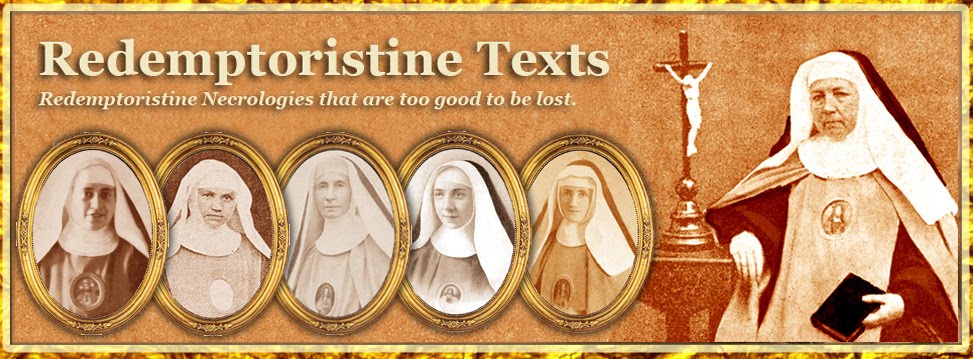



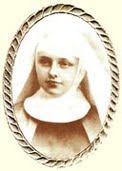

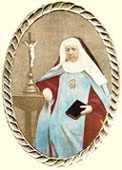
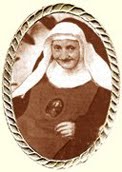
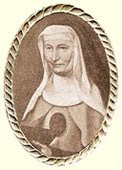













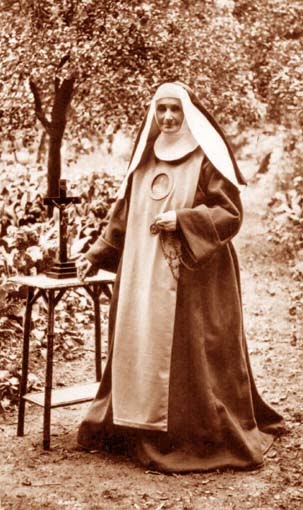

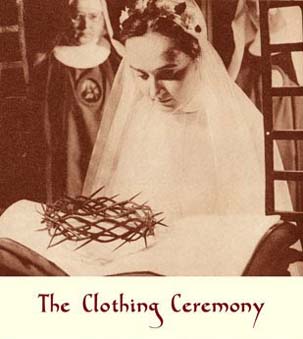
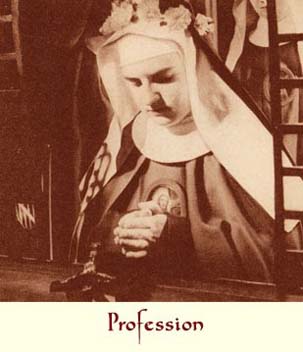



No comments:
Post a Comment